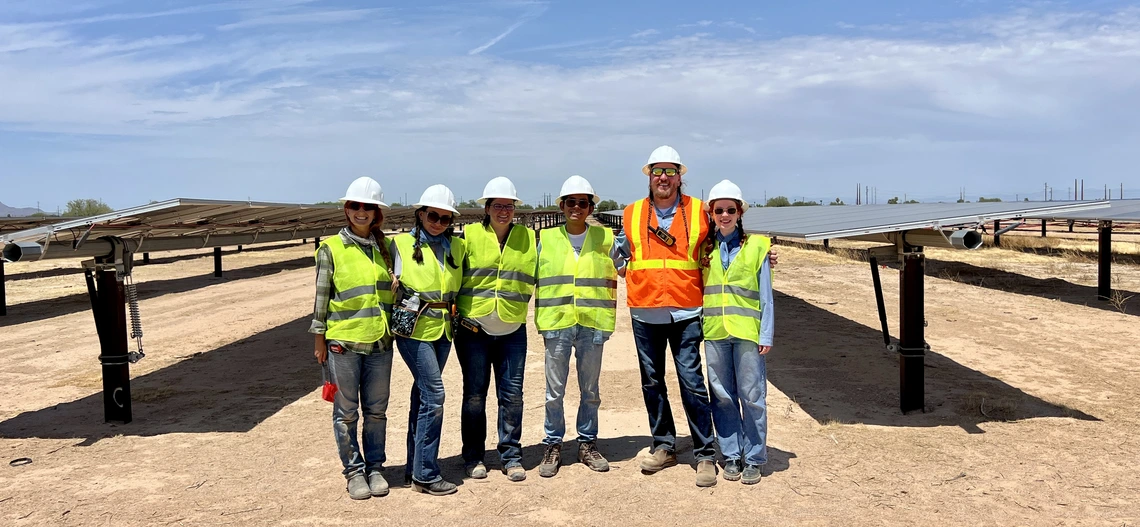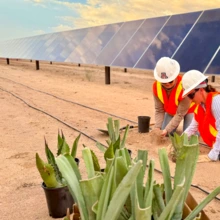Funding for Agrivoltaics Fuels Energy, Food, and Water Futures

Members of the SALSA team at the Foundational Agrivoltaics Research at Megawatt Scale FARMS site in Casa Grande, Arizona.
Last April, Professor Greg Barron-Gafford and his agrivoltaics team packed the room for their weekly meeting. Staff, undergrads, and grad students, all present. As the room buzzed with low conversation about departments losing federal funding, they felt confident — no news had come about their Department of Energy and Agriculture grants. Then, mid-meeting, the email arrived: their funding was canceled, retroactively, effective the day before. The room fell silent. Collectively, the people around the table represented years of work, from small-scale proofs of concept and observational studies to global network sites. The new question became: Who should even come in tomorrow?
“It was an absolute gut punch,” Barron-Gafford said.
Dual-Purpose Sustainability Model for the Desert
Agrivoltaics involves growing food underneath solar panels. While it might sound impossible, the research shows the two actually help each other, revealing that agrivoltaics not only improves crop yield in harsh conditions but also significantly boosts water use efficiency.
The shade from the panels keeps plants cooler and saves water — a critical issue in Arizona’s desert climate. At the same time, the plants release moisture into the air, which helps keep the solar panels from overheating, so they produce more energy.
The Semi-Arid Lab for Scaling Agrivoltaics, or SALSA, led by Barron-Gafford — Kellogg Chair, professor in the School of Geography, Development and Environment, and director of Food, Energy, and Water Resilience Solutions at Biosphere 2 — is a team of researchers, students, and collaborators who develop agrivoltaic systems to boost food, energy, and water resilience in arid regions, from local test plots to seven international sites.
For years, many people have argued it’s “food versus energy” — that farmland must be sacrificed if solar farms are built. Barron-Gafford disagrees.
“We don’t need food versus energy," he said. "We can have continued food production because of renewable energy.”

SALSA team members planting agave
Greg Barron-Gafford
The agrivoltaics model matters worldwide — and Arizona, with its intense sun and dwindling water supply, is the ideal proving ground.
“That balance between food and energy depends not just on crops, but on the panels themselves — which are surprisingly sensitive to heat. Solar panels are actually most efficient around 75 degrees,” said Barron-Gafford. “Once they get hotter than that, they lose efficiency. But when you grow plants underneath, their cooling effect keeps the panels closer to that sweet spot.”
SALSA partners with researchers in Mexico, Israel, and across Africa to test how agrivoltaics performs in different climates and cultures. These collaborations underscore that the need for food and energy is universal, and the answers developed in Arizona are guiding innovation internationally.
A Collapse and A Lifeline
Just as SALSA was gaining momentum, a major setback hit. Federal agencies that had pledged millions of dollars in support suddenly pulled out.
“We had about $4 million from the USDA. We had $1.2 million from the Department of Energy … and all of a sudden it went to zero,” Barron-Gafford said.
The loss didn’t just threaten his lab — it put graduate students, farmers, and international collaborations at risk.
Graduate students suddenly faced the possibility that their research, and even their livelihoods, might vanish overnight. Farmers who had agreed to participate in field trials were left in limbo, unsure whether the university could honor its commitments. Years of relationship-building hung in the balance.
“I felt like I had failed … everyone on our team is like family,” Barron-Gafford said.
That was when the Thomas R. Brown Family Private Foundation, or TRBFPF, stepped in and committed the funding that allowed the team to keep moving forward. That support has kept irrigation systems running, staff employed, and a large-scale demonstration site in Casa Grande active.
TRBFPF focuses on education and research, workforce development, and civic leadership, and the University of Arizona is the foundation’s largest grant recipient.
“The Brown Foundation came in at the absolute right moment in time,” Barron-Gafford said.
Their total commitment is bridging the gap while federal agencies recalibrate.
“We really were on CPR,” Barron-Gafford said. “And when the Foundation said, ‘Well, we’ll do this for three years.’ I thought, wow, here we go!”
“We understand the magnitude of the investment that had been made and the cost to students and research of a sudden interruption in the work plan,” said Sarah Smallhouse, chair of the board of directors and president of the Thomas R. Brown Family Private Foundation. “Agrivoltaics research aims to develop at least a partial solution [to the food-water-energy challenge], especially for poor and remote populations. We hope the impact of our gift will be to reduce unnecessary delays in developing economical systems that can be put into practical use as soon as possible.”
TRBFPF also trusted the researchers to make the best decisions as to how the money should be spent.
“They told us, ‘You know what’s most important,’” Barron-Gafford said. “‘You make that call.’”
“In our view, the people closest to the research are the ones with the best judgment on how to use funding given extreme uncertainty and tight financial constraints,” said Smallhouse.
TRBFPF's support has done more than just keep the research going. It has prompted others to pay attention.
“This support from the Thomas R. Brown Family Private Foundation has generated other groups to say, ‘Well, if they think it’s important, so do we,’” Barron-Gafford said.
Inquiries about partnerships and matching support have followed, creating momentum that would not have existed without its involvement. By stepping in when others stepped back, the philanthropic family foundation not only bridged a funding gap but also gave the research renewed visibility.
With the interim funding in place, the research team can focus on the future. The team’s large-scale demonstration site in Casa Grande is active — combining food and energy production, showing farmers what’s possible with limited water, and sustaining irrigation and staff. The site is the largest crop-based agrivoltaic system in the US.
“As farmers get less water, we’re building a solution that uses less,” Barron-Gafford said. “Our North Star is to produce food in rural landscapes while producing renewable energy.”
##
This story was included in the fall 2025 Developments newsletter.

